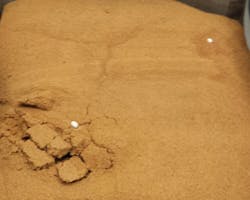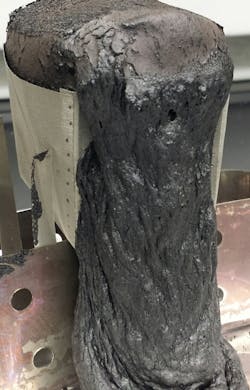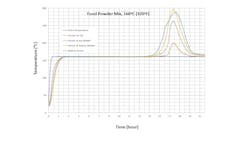A food product plant had been running a spray dryer and other powder handling processes for over 30 years without any fire or explosion incidents. However, between midnight and dawn on a Friday morning, a fire erupted from the powder bed in the spray dryer, which ignited the airborne dust at the discharge end of the dryer. The flash-burning dust cloud engulfed a night-shift dryer operator who was working at the discharge end of the dryer at the time. What was puzzling was that no abnormalities had been noticed before the fire. The company brought in Princeton Safety Solutions, a process safety consulting company, to determine what caused the severe fire and explosion in such a “normal” dryer.
Incident investigation
Right after the site was secured, the investigators conducted an onsite investigation, which included site inspections and surveys, photo and video documentation of the site, sample collections and plant personnel interviews. After the site inspection, the team performed a systematic testing of the dust fire and explosion hazard properties of the powder produced by the spray dryer.
The minimum ignition energy (MIE) of the powder sample prior to the incident was measured to be between 300 and 1,000 mJ. The investigation found no ungrounded metal parts in the dryer, and the dried powder was unlikely to be able to give rise to static sparks under the given process conditions. Even if there was a spark, the energy of the spark would have been much less than the powder’s MIE. Moreover, there were no electrical and mechanical ignition sources. Therefore, the only plausible ignition source in this incident was the heat in the dryer. The fire must have occurred in the powder layer first, which then caused the ignition of the airborne dust.
The inlet air temperature of the primary drying chamber was controlled at about 360oF (182oC). The minimum ignition temperatures (MITs) of dust clouds and dust layers of typical food powders are much higher than this temperature, as shown in Table 1. The MIT data suggests that the food powder could not have been ignited by the hot equipment surfaces in the dryer, which appears to be counterintuitive to the investigation’s conclusion that the heat in the dryer was the source of ignition.
However, the ignition was a result of “self-heating” or spontaneous combustion of the powder as it was subjected to the heat in the dryer. As revealed in other dryer fire investigations (fluid-bed, spray and flash dryers) including those conducted by Princeton Safety Solutions, many times, self-heating plays the major role as the ignition source for dryer fires, as well as other fires and explosions.
What is self-heating?
If a material undergoes exothermic (heat releasing) chemical reactions or decomposes exothermically, the heat released from the exothermic reactions or decomposition raises the material’s temperature. Some of this heat is lost to the environment, and if the rate of heat loss to the environment exceeds the rate of heat generation, the temperature of the material will go back to the ambient temperature. Otherwise, the temperature will increase. Due to the poor thermal conductivity of many bulk solids, a large portion of the reaction heat is retained in the powder. The temperature increase of the material due to the exothermic reaction will further increase the chemical reaction rate, which in turn will cause the temperature to increase further.
The increase of material temperature also results in an increase in the rate of heat loss. However, the rate of heat loss increases linearly with temperature, while the chemical reaction rate, and thus the heat generation rate, increases exponentially with temperature. Consequently, the heat generation rate will exceed the rate of heat loss and the temperature of the material will rise higher and higher. This process is referred to as self-heating. Self-heating begins at a temperature at which the rate of heat generation is greater than the rate of heat loss, which is called the exothermic onset temperature.
Self-heating of bulk solid materials begins with smoldering, which can set the material on fire (Photo 1). The fire can ignite airborne dusts particularly when the smoldering material is disturbed and exposed to air. Self-heating reactions may also produce flammable gases, which may lead to gas explosions in process vessels. Self-heating can also compromise product quality (Photo 2).
The exothermic onset temperature is influenced not only by a material’s chemical and physical properties, such as chemical reaction kinetics and heat of reaction, but also by other factors, including:
- Powder composition, including additives and contaminants;
- Size of the powder pile;
- Bulk density;
- Availability of oxygen in the bulk;
- Porosity;
- Ambient airflow; and
- Heating time.
Determining the risk of self-heating
Self-heating is a very complex chemical and physical process. In this investigation, the following experimental solution2 was used to determine the onset temperature of self-heating.
Screening tests. Screening tests were conducted to determine whether this powder could self-heat under the conditions that existed in the dryer before the incident. A powder sample from the incident batch was tested in a temperature-programmed oven, and the temperature of the oven was increased at a constant rate from room temperature to 752oF (400oC), as shown in Figure 1. As Photo 3 shows, self-heating resulted in spontaneous combustion of the powder mix sample. Some exothermic activity occurred at temperatures above 320oF (160oC), which was lower than the inlet hot air temperature of 365oF (185oC). The results indicated that self-heating was the probable ignition source for this fire incident. However, since the oven temperature was increasing, the screening tests could not accurately determine the onset temperature, only provide a useful estimate.
Isothermal heating tests. Isothermal tests at conditions close to the actual dryer conditions can yield more representative results of the self-heating hazards. In addition, results of isothermal tests can be used to estimate the onset temperatures of powder piles inside plant-sized equipment.
In this investigation, the sample of the powder that was being dried in the same incident batch was tested in three different sample sizes. In each trial, the powder sample was exposed to a constant temperature to test if self-heating could occur. The highest temperature at which self-heating did not occur and the lowest temperature at which self-heating did occur were determined. The average value of these two temperatures was taken as the exothermic onset temperature for each sample size.
Figure 2 shows the results of one of the tests. Usually, the material must be exposed to an elevated temperature for an extended period of time before it self-heats. This period is called induction time and is dependent on temperature. The higher the temperature of the material, the shorter the induction time. In this test, a sample in a 5-cubic-centimeter sample holder started to self-heat after having been exposed to hot air at 320oF (160oC) for over 13 hours. The self-heating powder eventually reached the flaming ignition temperature. The dryer inlet air temperature was controlled at 360oF (182oC). In the half-hour period prior to the fire, the inlet hot air temperature rose from 360oF (182oC) to 365oF (185oC). These test results proved that the fire was most likely ignited due to self-heating.
The study was expanded to test several other powders the company makes. Based on the test results, the investigators provided a list of recommended concrete actions to effectively eliminate or minimize the self-heating hazards.
Conclusions
Self-heating, due to the thermal instability of materials, often results in product quality problems, fires and even dust and gas explosions. It is an inherent hazard of drying processes and dryer operations. Self-heating can result in severe consequences such as worker injuries, equipment and plant damage, OSHA citations, lawsuits and business interruptions.
The spray dryer fire and explosion investigation presented here demonstrates that having no knowledge or an improper understanding of the thermal instability properties of powders is a common cause of dryer fires and explosions. This incident investigation also shows that self-heating and spontaneous combustion in dryers can be eliminated or controlled by determining the onset temperature of self-heating (or spontaneous combustion) of materials to be dried and implementing other relevant safety measures, including:
- Controlling the powder temperature below the onset temperature of self-heating with a safety margin.
- Designing and constructing dryers and associated equipment to prevent the formation of dead zones where powder deposits could build up.
- Preventing powder accumulations from reaching hazardous levels.
Applying the tests described in this article can help processors achieve safe drying operations. It is also important to examine adequate fire and explosion protection measures and additional safety measures for avoiding or eliminating other ignition sources.
References
- Rolf K. Eckhoff, “Dust Explosions in the Process Industries,” 3rd Edition, Gulf Professional Publishing, 2003, Elsevier Science (USA).
- John Abbott, "Prevention of Fires and Explosions in Dryers,” 2nd Edition, The Institution of Chemical Engineers, 1990.
Dehong Kong, PhD, is president of Princeton Safety Solutions and a member of the NFPA 484 and NFPA 30B technical committees.
Princeton Safety Solutions
About the Author

Dehong Kong
President, Princeton Safety Solutions
Dehong Kong, PhD, is president of Princeton Safety Solutions and a member of the NFPA 484 and NFPA 30B technical committees.






